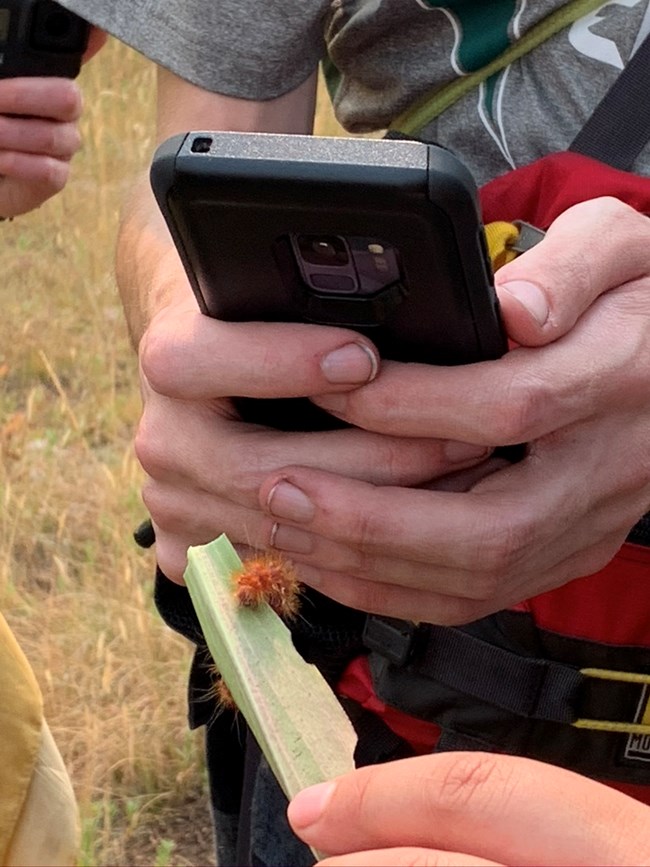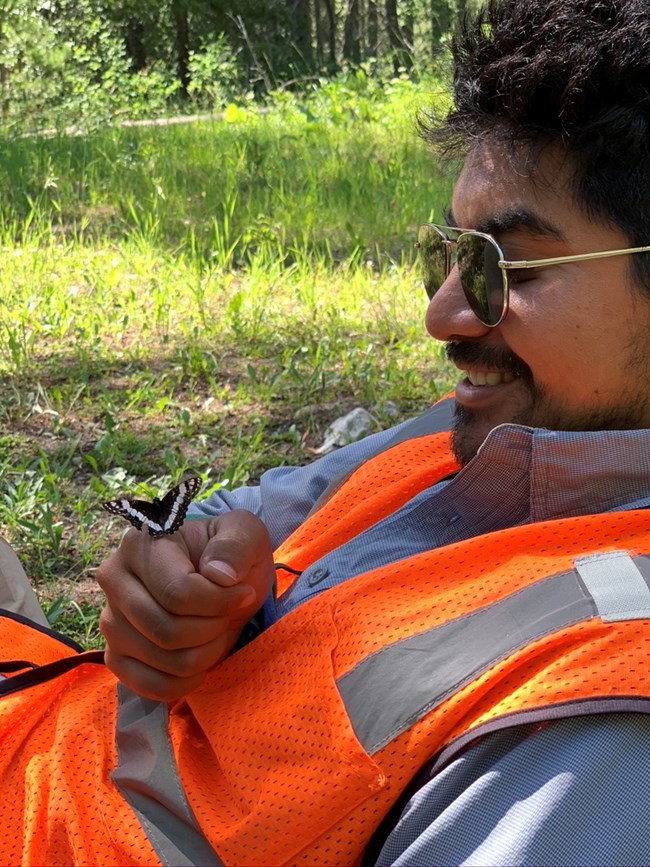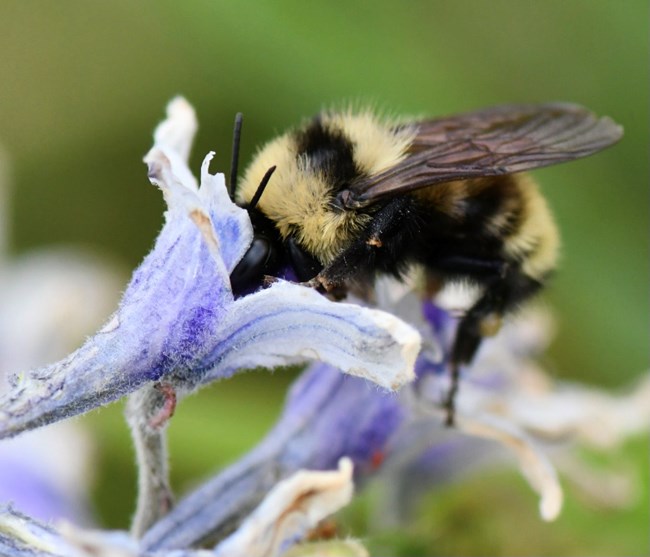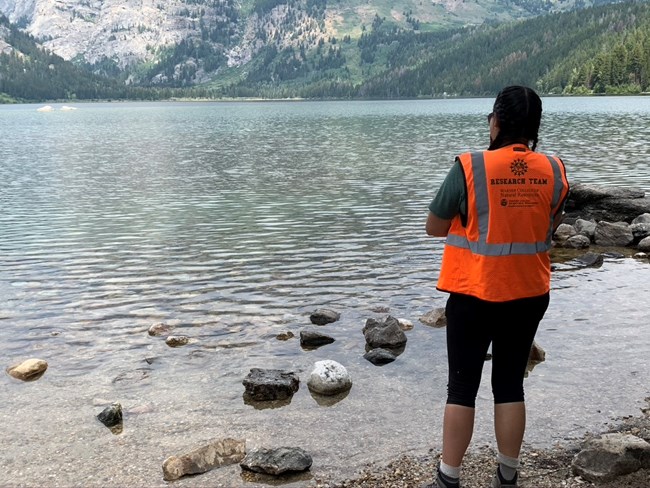Last updated: August 2, 2021
Article
Climate Change Communication Series: Dr. Gillian Bowser, Research Scientist
Dr. Gillian Bowser studies small creatures that tell a big story. Her research on pollinators demonstrates how insects are sentinels of change because their short generations mean they evolve faster and can quickly respond to changes in our climate. Dr. Bowser is a research scientist and associate professor at Colorado State University, but she began her career as a Yellowstone National Park wildlife technician on a backcountry campsite inventory team. From there, she went on to work as a wildlife biologist and ecologist at parks such as Yellowstone, Grand Tetons, Joshua Tree, and Wrangell St. Elias, and worked at the headquarters office of the National Park Service. She also participated in the U.N. Framework on Climate Change Convention and the U.N. Global Environmental Outlook.
In the following interview, Dr. Bowser explains how we need to focus less on the specific impacts of climate change and more on the protection of the greater system. There may not be much we can do about the shifting of species, such as the loss of some species and the rising prevalence of others. Trying to restore our National Parks to what they once were is a sticky issue, both ecologically and culturally, because therein lies the question of: “What do we restore to?” She argues that what matters instead is working on solutions that safeguard the system in place for future generations, even as that system is altered by climate change. Everyone, from park visitors to park scientists to those who have never been to a park, can contribute to the protection of parks by collecting data and practicing solutions, even in their own backyards. Throughout her career, Dr. Bowser has championed the fact that we can all be climate change scientists, and she invites young minds from diverse backgrounds to study a phenomenon that will affect every one of us. According to Dr. Bowser, the tools we need to study climate change are already widely available through mobile phone citizen science apps and crowdsourced databases, but the potential to open the field to all lies in how the experiment is designed. The question that remains is: do we have the will?

Photo courtesy of Dr. Bowser
What drew you to research climate change, and where do you see yourself fitting into its story?
“I went to graduate school to get a degree in biology under the Park Service, and we had to come up with a project that impacted Yellowstone. A woman who advised me was Dr. Mary Meagher, who was probably one of the first women scientists in the Park Service studying bison in Yellowstone National Park. She got me to work on insects, because they were organisms that in her view, no one had ever paid attention to in this park. We looked at the changing phenology of butterflies and their host plants in this one site that Mary picked out on the west side of the park. And what’s interesting is that now my PhD student many years later is looking at the same site, and we’re finding this amazing shift between her data and my data. For example, snow-free days in that one site have shifted by almost two months and may provide amazing insights on climate shifts impacts on biodiversity within the park itself."
“So this brings climate change home and makes it become more personal, maybe more exciting, in something like a National Park. We sort of have a vision that parks should stay the same. I think climate change is about change. Cities and neighborhoods change a lot. But we are uncomfortable with this option that things in parks may have changed and shifted to the point where we don’t know what is original anymore. And I think National Parks struggle with that more because our mandate is ‘to preserve and protect’ and people really take that to heart. But maybe climate change is forcing a change we can’t do anything about. I was at a conference, and one of the questions the panelists asked was “What do we restore to under climate change?” And we may not understand what that ‘to’ is because the water temperature has changed, the land temperature has changed, the growing season has changed. And if we put back in a species that was there before whatever wiped it out, it may not be successful because now it is three, four degrees warmer. So what are we restoring to?”
“Urban parks are constantly dealing with this problem: how do we manage this place in this constant changing mass of humanity? Whereas a park like Yellowstone puts its boundaries up and thinks that the boundaries are actually solid and they’re not. It’s not about controlling visitation, it’s not about controlling [invasive species like] cheatgrass. The entire environment is changing at a very rapid rate. So I think it’s a philosophical question as to how you see things change and what you accept.”

Photo courtesy of Dr. Bowser
What emotions do you feel when you look forward to the future of National Parks as climate change progresses? It seems that you have some hope.
“What gives me hope is the term change. The visitors of parks need to change because the parks need to be protected by everybody. And climate change forces us to rethink what we mean by ‘preserve and protect for this and future generations.’ What are we preserving and protecting, and who are those future generations? And I think that’s an exciting change because then we have to really, really embrace adaptive management. We can’t return it to what somebody thought it looked like in 1860 and we can’t return it to a park that only invites certain segments of the population and not others because the future populations we’re supposed to protect it for will look different than the current demographics visiting the parks today.”
“Can we win this battle with climate change? We may not. And nobody likes to be the one to say that. So how do we adapt? One adaptation strategy is that you got to get the data, and that data may not be from an expert. It may be from a mobile phone. Back in Yellowstone, we would use satellite radio collars on elk and bison but we’d get these wacky positions with locational errors. Today you can take a picture of a bumblebee on your cell phone and upload it and you will be within a meter accuracy. So that changes how we can ask the question.”
“[Through citizen science], we can inform the public about all these species that are out there, that the public can take pictures of and upload. And then you can multiply that by a million people. Now you've got pretty darn good information about that species out there. The parks need to do this. They so need to do this, especially for the common species like the American bumblebee -- it doesn’t need to be a rare or sensitive species. And that's what we're trying to do with our pollinator project. If we could get every park visitor to take a picture of when they see a bumblebee on the roadside, we could probably map species in very fine detail and understand pollinator changes within protected areas under climate shifts.”
“What’s so exciting is that everybody has a cellphone in their back pocket, right? So you have the potential to engage anyone. The question is, do you have the will? Citizen science as a field is not very diverse, but the potential is based on who designs the experiment, not who participates. The tool could be the exact same, but it depends on who you have designed the experiment for.”
“So last year what we did is we took our students and we trained them. Our student groups are about 80 to 90% diverse because we work with the Louis Stokes Alliance for Minority Participation in Science (funded through National Science Foundation) to go out and collect pollinators. They first had to do a backyard BioBlitz where they had to go out into their own backyards and collect 10 species of pollinators every day, and we got 400 or 500 species just in backyards! But what that meant was later in the summer, when we were able to take students into the park, they knew what they were looking for because they'd already seen the same organisms in their own backyard. It engages them in science, it engages them in ecosystem processes, it engages them with parks and protected areas because now the tools are available to everybody. So it's that type of thing, which I think is such great hope because climate change ties us with this issue of change. And our cell phones allow us to measure it and it allows everybody to measure it so we can all be part of the solution to our parks.”

Photo courtesy of Dr. Bowser
In your recent talk for Women’s History Month, you spoke of how landscapes have culture, and how people’s and especially students’ perspectives change when they learn that their ancestors walked on a landscape. With this idea in mind,
how would you recommend framing climate change messages?
Do you think it is best to begin with an idea of place, and the various cultural ties one may have to the land, before stemming into the science, impacts, and solutions of climate change?
“The issue of landscape has its own culture and acknowledging those cultures that pass through landscape is so important because we approach climate change as A) an impact and B) as something that we’re going to restore to. So do we restore to colonialism or do we restore to what maybe the Native American cultures saw? And we haven’t been using any traditional ecological knowledge to define that impact. We're only using our colonial lens, so to speak, for that impact. The park service has set up by its mandate a mission statement that often has trouble incorporating different ways of knowing. So it defines those impacts on one way of knowing. We manage on one single cultural perspective. People lived on these lands for thousands of years, what they see as that impact and change might be very different than what we think we see. That’s the hardest story to figure out -- how do we be sensitive of traditional ecological knowledge that goes back hundreds of generations, with climate change that’s moving us to someplace else in front of us? The Pueblo culture will talk about what they did to their crops in earlier times when they experienced drought. Yet we don't ask them, what should we think about when it comes to restoring the state of Arizona when we face extreme heat? That knowledge is probably there.”
“When you talk about interpreting, do you focus on climate change or do you focus on the impact and ask who defines what? It’s like how we define invasives on a purely European view. Like the city of Fort Collins, we talk about the emerald ash border wiping out all the ashes, but this was a shortgrass prairie before the city was here. There were no trees. So we can talk about returning it back to shortgrass prairie, and probably all the suburban homeowners would have a heart attack, but that’s probably the climate change solution. It was never meant to be a forested area in terms of its ecosystem and it’s not heading towards being a forested area. It’s going to be a drier area where the trees will be more challenged. But we’ve created this ecosystem and now we want to protect it.”
“We talk about conservation, but we don’t remember that conservation is entirely driven by culture. We’ve defined invasive species based on our own constructs. If you look at the National Park Service Act, it also says that we will leave ‘landscapes untrammeled by the human presence.’ There is nothing on this planet untrammeled by human presence, because we’ve changed the atmosphere. So the very core of our act, this preserve and protect, has been shifted, but we don’t know how to shift it. So when we start this pollinator project next year, we’re going to try to help educate people that pollinators are shifting. We don’t know if it’s good or bad, but they’re shifting.”
“Have you heard of multi-voltanism? Some insects can control their life cycle based on environmental factors. Basically if it’s warm, they’ll pump out as many generations as they can until it’s cold and then they go into stasis. So if you look at pollinators like butterflies, you get some species that will only have one flight a year, regardless of the temperature, they’ll come out once and they’ll disappear. Monarchs are a great example, you’ll have one generation a year. But you’ll have other species that have kind of figured this out, and they will pump out generations as long as there is a reasonable temperature. The Coleus and Pieris, yellow and white butterflies, will do that. They’ve gone from one flight a year to two flights, and now they’re up to three flights a year. So they’re having a pretty darn good time with climate change. But other species within that same group are still stuck at one flight a year. So that’s when we get what they call phenophase disconnect, because if the host plant shifts and the butterfly is not able to shift for whatever reason, that species is in more danger than the coleus butterfly, which is figuring this out and saying, “Okay, we’ll just have more flights this year, it’s still warm.” So is it an impact? I don't know. It's a change. You’ll see coleus butterflies come out now and they'll come out earlier and earlier, as soon as it warms up, but you're not going to see that shift in the monarchs. That's a timescale problem deep into their genetic history as to why. So how do we define the impacts of climate change? We will probably still see butterflies with climate change but we will probably see different butterflies with climate change.”
“It’s all about perception and what we give value to and what we don’t. For example, it's very hard to get insects on the Endangered Species List because most people just don't connect with insects. And yet they might be a much better indicator of change than elk or bison. If you ask about climate change with elk or bison, people are probably trying to tell a story. But the animal lives too long. You probably really can't tell a whole lot about how it's changed. But if you look at insects, you'll see this dramatic increase. Like again, from my sample site to my students' sample site, we see a two months shift in species emergence and that is pretty dramatic.”

Photo courtesy of Dr. Bowser
What climate change solutions are you most excited about?
“What excites me is to see the youth excited and for them to have those citizen science tools to do something about it. Our students are so passionate right now about saving the planet. A bunch of us work on the international climate negotiations where we take students to the UN each year, the negotiations will be in Glasgow, Scotland this year. I think it is our responsibility to fix the mess that we made in terms of climate change. I don’t think that means we’re going back to something. We're not going to reintroduce the dinosaurs or the North American camel anytime soon, despite Jurassic park. I think we’re going to a new normal, and being able to accept and embrace that new normal is what we should focus on. We should slow down the extinction of species due to our carelessness, but we may not be able to change species movement.”
Golden Gate focuses a lot on “community-level solutions” because we believe that true change will stem from individuals working together. Examples of these community-level solutions include opting into CCAs or engaging with civic leaders. On a smaller scale, we’ve also presented electric vehicle usage or “Meatless Mondays” as solutions. However, the community-level solutions that we suggest are not always viable for all communities, or in other words, are not always equitable.
Do you have any recommendations for more equitable climate change solutions that we can present during our programs?
“Sometimes solutions like a Meatless Monday are not actually solutions at all in the long run because we’ve taken the credit from one thing and dumped it to a credit for something else. And we may not have actually saved anything in the long run, because we turn around and spend the money on something else. But pollinators are actually really fun for this because a fun solution is to plant more flowers. And anyone can do that. The pollinators in Golden Gate are many of the same ones that are in Yosemite because pollinators work across huge landscapes. Invertebrates are such important bellwethers for climate change that we can do something about. It makes an enormous difference to plant pollinator friendly gardens, and it’s cheap. You can get a whole seed pack of daisies for $1.99. It’s not an enormous burden, but flowers have such a positive impact on our health and wellbeing and sense of belonging. Sometimes we don’t think of the really simple solutions. Planting more flowers or not mowing dandelions really do have an impact. We want to do something more difficult, like ride your bike to work everyday, but what if it’s 15 miles to work?”

Photo courtesy of Dr. Bowser
What is most important for National Park Service interpreters to communicate to the public about climate change?
“There are solutions and everyone can be part of it, whether it’s planting flowers or identifying pollinators and collecting that data with every visitor's cellphone (but do not harm or disturb the busy bee at work!) Parks should be part of that solution because people turn to parks as icons of, I would use the term ‘imperfect past,’ that we are protecting for their future generations.”“And we already talked about this, but maybe we should get rid of the preserve part. We don’t know what we’re preserving, but we’ve tried to protect the greater nature experience. That experience could be in an urban setting, just watching bees come to your windowsill garden is nature at its finest. And I think getting people just to be engaged is part of the solution, whatever their individual capacity is. We don’t need to wait for an administration to sign a piece of paper. The solution doesn’t need to be impact based, it needs to be protection based. We’re protecting this experience, whether it’s Yellowstone or Golden Gate, we’re protecting the experience even though the individual organisms in that experience are going to change and there’s probably not much we can do about that. But we don’t give up, we plant those wildflowers and maybe the bee species that will come to those wildflowers will change, but then we’ve still protected the pollination system, right?”
“Parks are supposed to be for future generations. We want that future generation to be hopeful that the park is going to still be here as an experience; its individual organisms will shift around regardless. That’s just part of nature. We need to protect what we have control over, like overuse of pesticides, because they do cause extinctions. When you throw climate change at bees and then you throw in pesticides on top of it -- so that early emerging dandelion, which bees could have adapted to, you then poison, it becomes like a double hit for those poor bees. And we know that, so why are we still doing it?”
“It’s this conundrum of understanding how to protect the whole being, even as it might continue to grow and change underneath you, that are parks at the best at. Helping people understand pollinators, helping people understand those processes and experiencing it. So what parks should be doing, they shouldn't be talking about impacts. I think that's a bad approach to be honest, too negative. We went through that with Yellowstone fires in 88. You know, “the park’s never going to be here again.” Well, Yellowstone is still there. And we shouldn't open that door to say, well, because Yellowstone has changed due to the 88 fires that maybe we should just open the rest of it up for logging anyway. And that battle did occur. So we need to instill here that whether the trees are burned or not burned, it's still an ecosystem process. It's still an ecosystem that's functioning. It just looks different today than it did before.”
“It's so important to me that we connect all people to parks because everybody needs to want to protect parks regardless of whether they visited or not, or what racial or ethnic demographic they come from, because it's such an important part of our ecosystem because it's protected. Are you familiar with the Six Americas report? One of the questions that they ask is this issue of climate action. Does climate change impact you personally? And most Americans still answer no. So then the question is, what climate action have you done? And most people put it in that sort of distinct third person, fourth person sense like, well, you know, maybe I'll eat less meat and that's my action. Maybe I'll think about that. Because they don't think that climate change impacts them. It's not their problem. It's somebody else's problem. I think that’s the message we want to challenge. We want people to do something and be active and be part of the solution."
Further Reading
Climate Change: Pacific Coast Science and Learning Center
Climate Change: National Park Service Subject site
Geologic Activity at Golden Gate National Recreation Area
Jobs and Internships at Golden Gate National Recreation Area
National Network for Ocean and Climate Change Interpretation (NNOCCI)
Interview by Lara Volski, April 2021.
